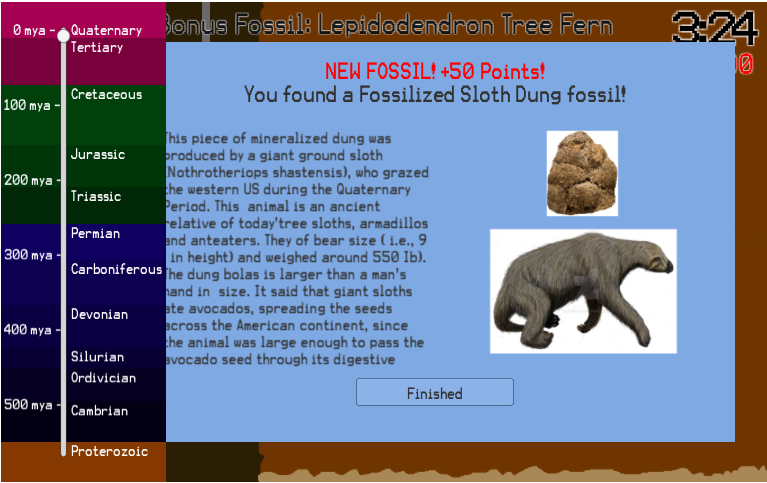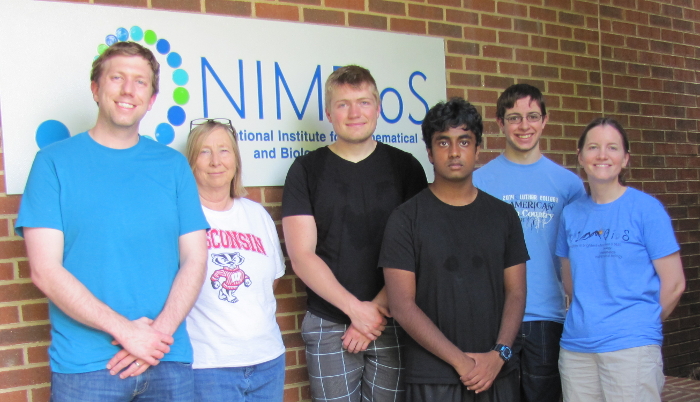New Fossil Computer Game Teaches Science, Math Fundamentals
September 26, 2016

|
| Fossilized sloth dung is a special fossil find in the new computer simulation game Fossil Finder! |
KNOXVILLE—Dig for fossils and learn about geologic time with a new computer game developed by undergraduate students at the National Institute for Mathematical and Biological Synthesis (NIMBioS).
Primarily aimed for students in grades 6-8, Fossil Finder! teaches the fundamentals of scientific notation, exponents as well as the concepts of geological time scales and the increasing complexity of life over time. Players travel in a mining elevator at a fossil excavation site to collect fossils from different geologic periods. While they race against the clock to dig through rock and find fossils, they must convert whole number years to scientific notation and vice versa in order to move their mining elevator between corresponding rock layers.
Played on a web browser, the computer simulation game was developed by three undergraduate students and their faculty mentors during an eight-week summer research program at NIMBioS. Another game, Cambrian Sea Explorer, which introduces players to the evolutionary history of biodiversity, is under development.
"The idea is to offer children novel learning experiences that are structured as entertaining games rather than merely tutorials and exercises," explained University of Tennessee, Knoxville, biology professor Susan Riechert, who was one of the mentors on the project.

|
| Fossil Finder! co-creators include, from left, Michael Jantz, Susan Riechert, Jacob Miller, Howsikan Kugathasan, Samuel Iselin and Kelly Sturner. |
"If a kid plays our games and it makes him or her want to learn more about science, then I would be pretty happy about that," said co-creator Jacob Miller, a senior in math and computer science at the University of Kentucky.
Fossil Finder! co-creators are also Samuel Iselin, a math major at Valparaiso University, and Howsikan Kugathasan, a math major at Fisk University. In addition to Riechert, the other mentors are Michael Jantz, a UT assistant professor in computer science, and Kelly Sturner, NIMBioS Education & Outreach Coordinator.
The game drew inspiration from the Biology in a Box program created by Riechert, which uses hands-on materials to teach integrated science, technology, engineering and math concepts to students in grades K-12. The game will become part of the program, which is used in over 90 school systems in Tennessee, Georgia, Kentucky, North Carolina and Washington, DC.
The game meets both Next Generation Science Standards for learning about unity and diversity in biological evolution and Common Core Mathematics Standards related to integer exponents and numerical expressions used in scientific notation.
The NIMBioS Summer Research Experience brought together a select group of 16 undergraduates from across the country to work on teams conducting research at the interface of math and biology.
Located on the UT campus, NIMBioS fosters new collaborative efforts to investigate biological questions using mathematical and computational methods.
Details about the game and the link to play it can be found at /education/fossil_finder_module
#
The National Institute for Mathematical and Biological Synthesis is an NSF-supported center that brings together researchers from around the world to collaborate across disciplinary boundaries to investigate solutions to basic and applied problems in the life sciences.
CONTACT:
Catherine Crawley, NIMBioS, +1-865-974-9350, ccrawley@nimbios.org
NIMBioS
1122 Volunteer Blvd., Suite 106
University of Tennessee
Knoxville,
TN 37996-3410
PH: (865) 974-9334
FAX: (865) 974-9461
Contact NIMBioS


